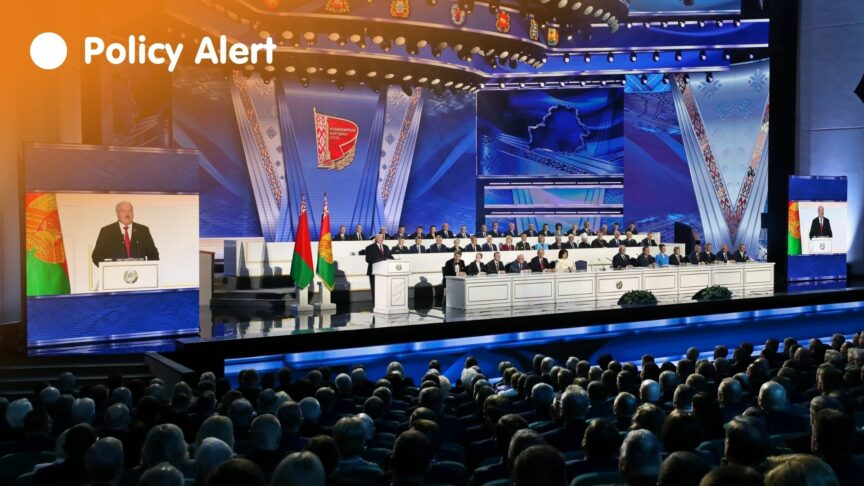Moldova next? How Europe should react to Russia’s implicit threat
Europeans should urgently increase Frontex assistance to Moldova, enhance intelligence cooperation, and consider positioning NATO units based in Romania closer to the country’s border
On 22 April, deputy commander of Russia’s Central Military District Rustam Minnekayev outlined the aim of the second phase of his country’s war on Ukraine. The goal was not only to take the Donbas region in the country’s east, but also to seize control of the southern coast of Ukraine – and to link up with the Moldovan breakaway republic of Transnistria.
The Kremlin officially stayed silent on the matter, and unofficially the Russian foreign ministry has denied it has plans for Transnistria. But, shortly afterwards, the quasi-authorities in Transnistria proclaimed they would “take decisions to protect the interest of the Republic”. As Transnistria is de facto a Russian operational base run by the FSB and GRU security services, this either means secession or other forms of military preparations to support Moscow’s war effort in Ukraine. Days later, attacks on uninhabited and unimportant military targets in Transnistria provided the pretext for the Transnistrian authorities to order a general mobilisation and tighten security measures.
So what could Russia’s intentions be? The combined Russian and “separatist” military contingent in Transnistria outguns the standing Moldovan armed forces. They total roughly one to two Russian mechanised battalions, along with 8,000 local auxiliary forces consisting predominantly of light infantry and the paramilitary security forces of the MGB (successor to the KGB). However, in these numbers they are too small to engage in the war on Ukraine on their own. They could only join battle if Russian forces were close by, distracting Ukrainian reserves, or already in the process of linking up to the breakaway region. In the last scenario, they could provide desperately needed infantry for the Russian military. However, the Russian advance towards Odessa has for weeks now been bogged down just outside the city of Kherson. The Russians would still need to cross the river Bug, which is very wide and with bridges only hundreds of kilometres apart from each other. Russia will not have sufficient forces available to do so before it concludes its Donbas offensive, which is progressing only slowly.
With Russia’s military stalled to the east, the timing of Moscow’s move in Moldova is puzzling at best.
With Russia’s military stalled to the east, the timing of Moscow’s move in Moldova is puzzling at best. It has given Chisinau the chance to prepare and rally international support. Moldova has put its security forces on alert, and public debate in the country is now focusing on mobilising the armed forces. The more time Moldova has to defend against either an attack from Transnistria alone, or from Transnistria combined with Russian forces, the more swiftly and effectively it will be able to respond. And while Moldova’s military capabilities are far below those of Ukraine, a country under arms may still prove a nightmare for Russia’s logistics and lines of communications through it. Resistance in Moldova could deny Russia a possible advantage in trying to push through the country to reach the Ukrainian rear.
What should Europe and the West do? The best life insurance for Moldova is, of course, to continue to support the Ukrainian armed forces stalling the Russian offensives in Donbas and Kherson. If Moscow’s armed forces never get anywhere near to Transnistria, nothing serious should happen.
In the meantime, the EU should increase Frontex assistance to Moldova’s border guards. This is essential to prevent Transnistria staging provocations, terrorist activities, or false-flag attacks to incite anti-Ukrainian sentiment or destabilise the government in Chisinau. Along the same lines, Europeans should intensify intelligence cooperation with Moldova to help foil such attacks and provide Chisinau with strategic pre-warning time.
Moldova’s military itself has unfortunately been neglected for decades. The country’s leaders have long assumed that geography – i.e. Ukraine – would prevent the worst. The new progressive president, Maia Sandu, and prime minister, Natalia Gavrilița, placed anti-corruption and rule of law reforms at the heart of their (peacetime) plans for government. Now the leaders have to focus on defence as well. The European Union has pledged support to the country through its European Peace Facility, but, even then, such reforms take years to materialise. With the situation in Ukraine developing rapidly, European leaders should urgently devise additional ways to assist Moldova.
One option is to move NATO Enhanced Forward Presence units in Romania close to the Moldovan border. If the situation worsens, Moldova could invite these forces to undertake “manoeuvres” on its own territory. Even if such training deployment were only nominal, for Russia the risks of transgressing into (government-controlled) Moldova would rise significantly. When Russia started to increase its deployments along the Ukrainian border in 2021, the West did not respond by deploying larger forces in kind. This limited its ability to credibly signal or deploy blocking forces for manoeuvres, thus also reducing its diplomatic options to calling out Russian intentions and threatening sanctions. The West should not make the same mistake again with Moldova.
The European Council on Foreign Relations does not take collective positions. ECFR publications only represent the views of their individual authors.



